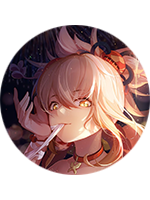Wallpaper的透视图实际上包含了两张图,一张是非透视图,即正常情况下能够被看到的图片,另一张是透视图,即鼠标移到上面才会部分显示的图片.
本文将使用Qt框架实现类似效果
最终效果

代码
桌面子窗体
将自己的窗体设置成桌面的子窗体,其原理在之前的Wallpaper文章中已经介绍过,故直接放出代码,不再解释.
1
2
3
4
5
6
7
8
9
10
11
12
13
14
15
16
17
18
19
20
21
22
23
24
25
26
27
28
29
| void SetFather(HWND child){
HWND hwnd = GetBackground();
if(hwnd == NULL){
SendMessage(hwnd,0x052C,0,0);
hwnd = GetBackground();
}
if(hwnd != NULL){
SetParent(child,hwnd);
}
}
HWND GetBackground(){
HWND hwnd = FindWindowA("progman","Program Manager");
HWND worker = NULL;
do{
worker = FindWindowExA(NULL,worker,"workerW",NULL);
if(worker != NULL){
char buff[200] = {0};
int ret = GetClassNameA(worker,(PCHAR)buff,sizeof(buff)*2);
if(ret == 0){
return NULL;
}
}
if(GetParent(worker) == hwnd){
return worker;
}
}while(worker != NULL);
return NULL;
}
|
鼠标事件捕捉
由于将窗体设置成了背景层的子窗体,而背景层上面还有一层图标层,所以我们自己写的窗体将无法接受鼠标事件,也就无法对鼠标移动做出反应,因此我们需要使用HOOK拦截系统的鼠标事件,HOOK程序将会在鼠标移动事件发生之前优先执行,这样就可以捕捉到鼠标移动事件.
1
2
3
4
5
6
7
8
9
10
11
12
| HHOOK hook;
void GetHook(){
hook = SetWindowsHookEx(WH_MOUSE_LL,mouseProc,GetModuleHandle(NULL),NULL);
}
LRESULT CALLBACK mouseProc(int nCode,WPARAM wParam,LPARAM lParam){
if(nCode == HC_ACTION){
if(wParam == WM_MOUSEMOVE){
main->repaint();
}
}
return false;
}
|
绘图与蒙版
实现透视效果的原理是先绘制非透视图,然后根据鼠标位置绘制透视图的一小部分,为了方便,我们称非透视图为“背景图”,称透视图为“前景图”,因为透视图是覆盖在非透视图上面的.
全局变量
1
2
3
4
5
6
7
8
9
10
11
| QPixmap *foreground;
QPixmap *background;
QPixmap *cut;
QBitmap *maskBitmap;
QPixmap *maskPic;
QColor *color;
int x1,x2,y1,y2;
int startX,startY;
int radius;
int Desktop_width,Desktop_height;
bool repaintable = true;
|
LoadPicture()函数用来加载图片
1
2
3
4
5
6
7
8
9
10
11
12
13
| void Widget::LoadPicture(QString fore,QString back){
foreground = new QPixmap();
background = new QPixmap();
cut = new QPixmap();
foreground->load(fore);
background->load(back);
QDesktopWidget *desktop = QApplication::desktop();
QRect rect = desktop->screenGeometry();
Desktop_width = rect.width();
Desktop_height = rect.height();
*foreground = foreground->scaled(rect.width(),rect.height(),Qt::IgnoreAspectRatio,Qt::SmoothTransformation);
*background = background->scaled(rect.width(),rect.height(),Qt::IgnoreAspectRatio,Qt::SmoothTransformation);
}
|
在SetRadius()函数中,需要初始化蒙版,先定义一个长为2*radius的正方形QBitmap,然后画上颜色为color(黑色)的圆形
1
2
3
4
5
6
7
8
9
10
11
12
13
14
15
| void Widget::SetRadius(int r){
if(radius == r) return;
radius = r;
QSize size(2*radius, 2*radius);
maskBitmap = new QBitmap(size);
maskPic = new QPixmap(size);
color = new QColor(0,0,0);
QPainter painter(maskBitmap);
painter.setRenderHint(QPainter::Antialiasing);
painter.setRenderHint(QPainter::SmoothPixmapTransform);
painter.fillRect(0, 0, size.width(), size.height(), Qt::white);
painter.setBrush(*color);
painter.drawRoundedRect(0, 0, size.width(), size.height(), radius, radius);
repaint();
}
|
根据鼠标位置计算出正确的区域大小,这是一个以鼠标为中心,2*radius为长的正方形,(x1,y1)是左上角坐标,(x2,y2)是右下角坐标,这两个坐标构成了一个裁剪框,但是这个坐标有可能会超出屏幕范围,一旦超出,就会导致裁剪的时候出现图片拉伸,所以需要加上判断语句来限制大小.
接着根据限制后的大小和位置,在前景图(透视图)上裁剪出相应区域.
startX和startY是蒙版的起始位置,如果(x1,y1)超出屏幕区域,就意味着裁剪框将不是正方形,而蒙版却是正方形的,所以必须对蒙版也进行裁剪,使蒙版的大小恰好等于裁剪框的大小.
1
2
3
4
5
6
7
8
9
10
11
12
13
14
15
16
17
18
19
20
21
22
23
24
25
26
27
| void Widget::paintEvent(QPaintEvent *){
GetCursorPos(&p);
x1 = p.x - radius;
y1 = p.y - radius;
x2 = p.x + radius;
y2 = p.y + radius;
if(x1 < 0) {
startX = -x1;
x1 = 0;
}else{
startX = 0;
}
if(y1 < 0) {
startY = -y1;
y1 = 0;
}else{
startY = 0;
}
if(x2 > Desktop_width) x2 = Desktop_width;
if(y2 > Desktop_height) y2 = Desktop_height;
*cut = foreground->copy(x1,y1,x2-x1,y2-y1);
*maskPic = maskBitmap->copy(startX,startY,x2-x1,y2-y1);
cut->setMask(maskPic->createMaskFromColor(*color,Qt::MaskOutColor));
QPainter painter(this);
painter.drawPixmap(0,0,width(),height(),*background);
painter.drawPixmap(x1,y1,x2-x1,y2-y1,*cut);
}
|
内存释放
HOOK会降低计算机效率,所以在使用完毕后必须释放,当关闭程序时windows系统会自动释放HOOK,但是我们希望用户在主动关闭壁纸但是还未退出程序时也要释放掉HOOK,同时摧毁窗体.
Dispose()函数的用途就是摧毁窗体,然后释放HOOK
1
2
3
4
5
| void Widget::Dispose(){
this->hide();
UnhookWindowsHookEx(hook);
this->close();
}
|
任务栏角标
之前文章已经介绍过,这里直接放出代码.
1
2
3
4
5
6
7
8
9
10
11
12
13
14
15
16
17
18
| void Set::AddTray(){
tray.setToolTip("X-Ray");
tray.setIcon(QIcon(":Icon/ico.ico"));
QMenu *menu = new QMenu();
QAction *action_showDialog = new QAction("打开主窗口");
QAction *action_free = new QAction("释放内存");
QAction *action_exit = new QAction("退出");
menu->addAction(action_showDialog);
menu->addAction(action_free);
menu->addSeparator();
menu->addAction(action_exit);
tray.setContextMenu(menu);
connect(action_showDialog,SIGNAL(triggered(bool)),this,SLOT(ShowDialog()));
connect(action_free,SIGNAL(triggered(bool)),this,SLOT(on_button_free_clicked()));
connect(action_exit,SIGNAL(triggered(bool)),this,SLOT(on_button_exit_clicked()));
tray.show();
}
|










